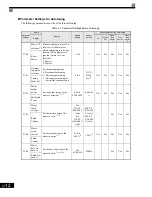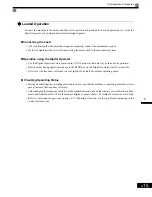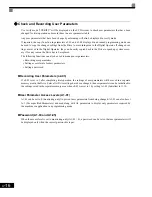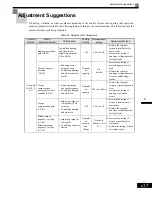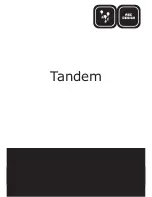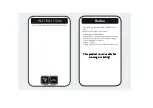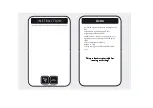
Trial Operation Procedures
4-
7
Settings for the Control Methods
Autotuning methods depend on the control method set for the Drive. Make the settings required by the control
method.
Overview of Settings
Make the required settings in quick programming mode and autotuning mode according to the following flow-
chart.
Note If the motor cable changes to 50 m or longer for the actual installation, perform stationary autotuning for the line-to-line resistance only on-site.
* 1. Use rotational autotuning to increase autotuning accuracy whenever it is okay for the motor to be operated. Always perform rotational autotuning when
using open-loop vector control 2.
* 2. If there is a reduction gear between the motor and PG, set the reduction ratio in F1-12 and F1-13.
* 3. The default setting of the Drive is for open-loop vector control 1 (A1-02 = 2).
* 4. If the maximum output frequency and base frequency are different, set the maximum output frequency (E1-04) after autotuning.
Fig 4.3 Settings According to the Control Method
START
YES
V/f
V/f control?
(A1-02 = 0 or 1)
PG?
Motor cable over
50 m or heavy load possibly
causing motor to stall
or overload?
NO
(Default: A1-02 = 0)
YES
(A1-02 = 1)
NO
Vector (A1-02 = 2, 3, or 4)*3
Set E1-03.
V/f default: 200 V/60 Hz(400 V/60 Hz)
Set E1-03, E2-04, and F1-01.
V/f default: 200 V/60 Hz(400 V/60 Hz)
NO
YES
YES
NO
END
*2
Control mode selection
OK to operate
motor during autotuning?*1
Rotational autotuning*4
Stationary autotuning*4
Stationary autotuning for
line-to-line resistance only
Summary of Contents for CIMR-G7U
Page 2: ......
Page 7: ...v...
Page 32: ...1 18...
Page 90: ...3 16...
Page 112: ...4 22...
Page 382: ...6 164...
Page 410: ...7 28...
Page 454: ......
Page 455: ......




















